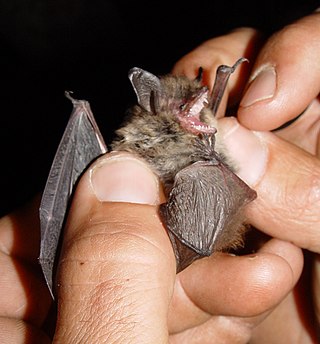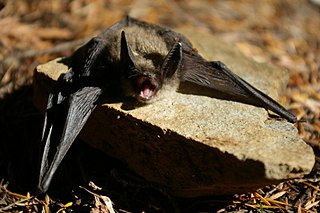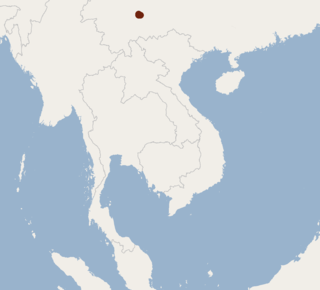
The whiskered bat is a small European bat with long fur. Although uncommon, M. mystacinus is often found around human habitation and around water; it is similar to Brandt's bat, from which it was distinguished as a separate species only in 1970.

The mouse-eared bats or myotises are a diverse and widespread genus (Myotis) of bats within the family Vespertilionidae. The noun "myotis" itself is a Neo-Latin construction, from the Greek "muós and "oûs", literally translating to "mouse-eared".

The fraternal myotis is a species of vesper bat native to East Asia.

The large-footed bat, large-footed mouse-eared bat, or large-footed myotis is a species of vesper bat. It can be found in the following countries: Australia, Indonesia, Malaysia, Papua New Guinea, Singapore, Solomon Islands, Taiwan, Vanuatu, and possibly Vietnam.

Peters's myotis or the small black myotis is a species of insectivorous vesper bat. It is found in Indonesia, Malaysia, Thailand, Vietnam, and the Philippines; its exact distribution is uncertain as it is difficult to distinguish from some other Myotis species. It appears adaptable to a variety of habitats, including primary tropical moist lowland forest, secondary forest, agricultural areas and villages.

The Gomantong myotis is a species of bat in the family Vespertilionidae that is endemic to Sabah district of Malaysia.

Keen's myotis is a species of vesper bat. It is found in British Columbia in Canada and in Washington and Alaska in the United States. It is named after the Rev. John Henry Keen, who collected the specimen that formed the basis for the first scientific description of the species. Classification for Keen's myotis formerly included the northern long-eared myotis, resulting in older studies confusing the species for one another.

The pallid large-footed myotis or Philippine large-footed myotis is a species of vesper bat. It can be found in the following countries: Malaysia and Philippines. It is found in caves and arable land.

The Burmese whiskered myotis or Burmese whiskered bat is a species of vesper bat. It is found in China, India, Myanmar, Laos, and Vietnam.

The thick-thumbed myotis is a species of vesper bat. It can be found in Cambodia, Laos, and Thailand.
Scott's mouse-eared bat is a species of vesper bat. It is found only in Ethiopia, in subtropical or tropical moist montane forests and shrubland. It is threatened by habitat loss.

Myotinae is a subfamily of vesper bats. It contains three genera: Eudiscopus, Myotis, and Submyotodon. Before the description of Submyotodon and analysis of its phylogenetics, as well as a phylogenetic analysis of Eudiscopus, the only member of Myotinae was Myotis.
Myotis phanluongi is a species of mouse-eared bat. It was described by Borisenko et al. in 2008. It is known from Vietnam. Very small Myotis species with forearm length about 34–36 mm, closely related to Myotis siligorensis. Described from the Hon Ba mountain in the Vietnamese province Khanh Hoa; also found on Đà Lạt Plateau.

The eastern water bat or Sakhalin bat is a species of mouse-eared bat. It was for a long time considered to be a subspecies of Myotis daubentonii.

The Bocharic myotis or Bokhara whiskered bat is a species of mouse-eared bat in the family Vespertilionidae, described in 1950, and indigenous to Tajikistan, and Uzbekistan.
The Armenian whiskered bat, also known as the Hajastan myotis or the Armenian myotis, is a species of bat from the family Vespertilionidae. The Armenian whiskered bat was formerly included as a part of the whiskered bat, but was considered distinct in 2000 as a result of morphologic comparison.

The chestnut myotis is a species of mouse-eared bat in the family Vespertilionidae. It is found in South Asia.

Myotis annatessae is a recently described species of bat in the family Vespertilionidae. It is endemic to Vietnam and Laos.















